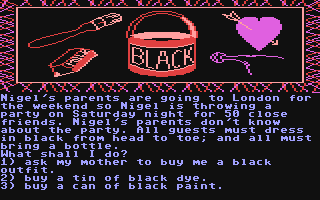|
The idea of having a program that really just tells,
a story by scrolling text up the screen and occasionally
asking the player to choose a course of action that
may alter the plot is not new. It all started with the
Fighting Fantasy books and was programmed on the Spectrum
by Five Ways Software a year or so ago. However, it
has never really caught on because of the problems of
fitting enough text into a cassette-based system to
make the whole exercise worthwhile.
Level
9 however, have achieved the notable feat of cramming
no less than 200K of text into four separate data blocks,
which altogether adds up 10 around 35,000 words if the
Wiz's Wordstar files are anything to go by. Each block
comprises further extracts from the diary of Mole, and
you can't move on to the next episode until you've finished
the earlier phases.

As
you play, pretty graphics appear at the top of the screen,
and what seems like endless text scrolls up the screen
below. Occasionally (and more frequently as the game
progresses), it halts and asks you to choose between
one of three alternatives. These are usually along the
lines of 'What shall I do: (1) Go to the party (2) Slay
at home (3) Invite Pandora to the party' and the plot
then unfolds, according to which selection you made.
There
are two obvious questions here. First, does the plot
really change all that much, and second, if you've already
read all the Mole books (millions have), is there going
to be anything here to hold your interest that you don't
know already?
Well,
there's no doubt that the plot does change quite a bit
as you proceed to make your various choices, but perhaps
not quite as much as one would like. The Wiz supposes
that this is because some things are really fundamental
to the plot -- like meeting Bert Baxter, the OAP --
and if you were to miss these out altogether then real
problems might arise with the script. As it is, if you
decide (as I did) not to visit Ben Baxter, the program
cleverly goes along with you for a while until it finds
an excuse to get you round to his house. It's done very
well, but it does have the effect of repeatedly introducing
certain events each time you play the game -- but then
that happens with all adventures, so one can hardly
complain.
What's
really remarkable about this program though, is that
50% of the material is completely original and different
from the existing Mole stories. The White Wizard simply
assumed that Mosaic had drafted in authoress Sue Townsend
to dream up some more dilemmas for her young hero, but
no! All the additions were made by Pete Austin of Level
9. Ye gods! The man's a genius! He's more like Sue Townsend
than Sue Townsend herself -- at least as far as the
script's concerned. With only one or two minor exceptions,
there wasn't a paragraph that couldn't have come from
the pen of Ms Townsend -- the text is hilarious, witty,
and beautifully written, and -- most important of all
-- it's full of surprises, even if you know the books
backwards.
As I've already said, I reckon this is an important
program. Now we've seen one series of books successfully
implemented on a micro using this technique, it's the
Wiz's, firm expectation that there will be more to follow.
Stand by for Live and Let Die -- and in the meantime,
get a copy of Adrian Mole!
|